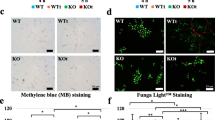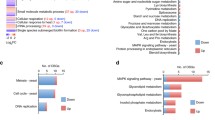Abstract
In the absence of steroid receptors and any known mechanism of gene regulation by steroid hormones in Candida albicans, we did a genome-wide analysis of C. albicans cells treated with progesterone using Eurogentec cDNA microarrays to find the complete repertoire of steroid responsive genes. Northern blotting analysis was employed to validate the genes that were differentially regulated by progesterone in the microarray experiments. A total of 99 genes were found to be significantly regulated by progesterone, among them 60 were up-regulated and 39 were down-regulated. It was observed that progesterone considerably enhanced the expression of multi-drug resistance (MDR) genes belonging to ATP Binding Cassette (CDR1 and CDR2) super-family of multidrug transporters, suggesting a possible relationship between steroid stress and MDR genes. Several genes associated with hyphal induction and the establishment of pathogenesis were also found up-regulated. In silico search for various transcription factor (TF) binding sites in the promoter of the affected genes revealed that EFG1, CPH1, NRG1, TUP1, MIG1 and AP-1 regulated genes are responsive to progesterone. The stress responsive elements (STRE; AG4 or C4T) were also found in the promoters of several responsive genes. Our data sheds new light on the regulation of gene expression in C. albicans by human steroids, and its correlation with drug resistance, virulence, morphogenesis and general stress response. A comparison with drug induced stress response has also been discussed.
Similar content being viewed by others
References
Prasad R, Worgifosse PD, Goffeau A, et al. Molecular cloning and characterization of a novel gene of C. albicans, CDR1, conferring multiple resistances to drugs and antifungals. Curr Genet 1995;27:320–9.
Sanglard D, Ischer F, Monod M, et al. Cloning of Candida albicans genes conferring resistance to azole antifungal agents: characterization of CDR2, a new multidrug ABC transporter gene. Microbiology 1997;143:405–16.
Fling ME, Kopf J, Tamarkin A, et al. Analysis of a Candida albicans gene that encodes a novel mechanism for resistance to benomyl and methotrexate. Mol Gen Genet 1991;227:318–29.
Krishnamurthy S, Gupta V, Panwar SL, et al. Expression of CDR1, a multidrug resistance gene of Candida albicans: In vitro transcriptional activation by heat shock, drugs and human steroid hormones. FEMS Microbiol Lett 1998;160:191–7.
de Micheli M, Bille J, Schueller C, et al. A common drug-responsive element mediates the upregulation of the Candida albicans ABC transporters CDR1 and CDR2, two genes involved in antifungal drug resistance. Mol Microbiol 2002;43:1197–214.
Hernaez ML, Gil C, Pla J, Nombela C. Induced expression of the Candida albicans multidrug resistance gene CDR1 in response to fluconazole and other antifungal drugs. Yeast 1998;14:517–26.
Puri N, Krishnamurthy S, Habib S, et al. CDR1, a multidrug resistance gene from Candida albicans, contains multiple regulatory domains in its promoter and the distal AP-1 element mediates its induction by miconazole. FEMS Microbiol Lett 1994;180:213–9.
Kinsman OS, Collard AE. Hormonal factors in vaginal candidiasis in rats. Infect Immun 1986;53:498–504.
Kinsman OS, Pitblado K, Coulson CJ. Effect of mammalian steroid hormones and leuteinizing hormone on the germination of Candida albicans and implications for vaginal candidosis. Mycoses 1988;31:617–26.
Gujjar PR, Finucane M, Larsen B. The effect of estradiol on Candida albicans growth. Ann Clin Lab Sci 1997;27:151–6.
White S, Larsen B. Candida albicans morphogenesis is␣influenced by estrogen. Cell Mol Life Sci 1997;53:744–9.
Zhang X, de Micheli M, Coleman ST, et al. Analysis of the oxidative stress regulation of the Candida albicans transcription factor, Cap1p. Mol Microbiol 2000;36:618–29.
Fidel PL Jr., Cutright J, Stelle C. Effects of reproductive hormones on experimental vaginal candidiasis. Infec Immun 2001;68:651–7.
Zakelj-Mavric M, Kastelic-Suhadolc T, Plemenitas A, et al. Steroid hormone signaling system and fungi. Comp Biochem Physiol 1995;112B:637–42.
Madani ND, Malloy PJ, Rodrigues-Pombo P, et al. Candida albicans estrogen-binding protein gene encodes an oxidoreductase that is inhibited by estradiol. Proc Natl Acad Sci USA 1994;91:922–6.
Malloy PJ, Zhao X, Madani ND, Feldman D. Cloning and expression of the gene from Candida albicans that encodes a high-affinity corticosteroid-binding protein. Proc Natl Acad Sci USA 1993;90:1902–6.
Das M, Datta A (1985) Steroid binding protein(s) in yeasts. Biochem Int 11:171–6
Karnani N, Gaur NA, Jha S, et al. SRE1 and SRE2 are two specific steroid responsive modules of Candida drug resistance 1 gene, (CDR1) promoter. Yeast 2004;21:219–39.
Banerjee D, Pillai B, Karnani N, et al. Genome-wide expression profile of steroid response in Saccharomyces cerevisiae. Biochem Biophys Res Commun 2004;317:406–13.
Cheng G, Yeater MK, Hoyer LL. Cellular and molecular biology of Candida albicans estrogen response. Eukaryotic Cell 2006;5:180–91.
Kinsman OS, Pitblado K, Coulson CJ. Effect of mammalian steroid hormones and luteinizing hormone on the germination of Candida albicans and implications for vaginal candidosis. Mycoses 1988;31:617–26
Panaretou B, Sinclair K, Prodromou C, Johal J, Pearl L, Piper PW. The Hsp90 of Candida albicans can confer Hsp90 functions in Saccharomyces cerevisiae: a potential model for the processes that generate immunogenic fragments of this molecular chaperone in C. albicans infections. Microbiology. 1999;145:3455–63
Felk A, Kretschmar M, Albrecht A, Schaller M, Beinhauer S, Nichterlein T, Sanglard D, Korting HC, Schafer W, Hube B. Candida albicans hyphal formation and the expression of the Efg1-regulated proteinases Sap4 to Sap6 are required for the invasion of parenchymal organs. Infect Immun 2002;70(7):3689–700
Dieterich C, Schandar M, Noll M, Johannes FJ, Brunner H, Graeve T, Rupp S. In vitro reconstructed human epithelia reveal contributions of Candida albicans EFG1 and CPH1 to adhesion and invasion. Microbiology 2002;148(Pt 2):497–506
Fu Y, Ibrahim AS, Sheppard DC, Chen YC, French SW, Cutler JE, Filler SG, Edwards JE Jr. Candida albicans Als1p: an adhesin that is a downstream effector of the EFG1 filamentation pathway. Mol Microbiol 2002;44(1):61–72
Leng P, Lee PR, Wu H, Brown AJ. Efg1, a morphogenetic regulator in Candida albicans, is a sequence-specific DNA binding protein. J Bacteriol 2001;183:4090–3.
Braun BR, Johnson AD. TUP1, CPH1 and EFG1 make independent contributions to filamentation in Candida albicans. Genetics 2000;155:57–67.
Braun BR, Head WS, Wang MX, et al. Identification and characterization of TUP1-regulated genes in Candida albicans. Genetics 2000;156:31–44.
Murad AM, d’Enfert C, Gaillardin C, et al. Transcript profiling in Candida albicans reveals new cellular functions for the transcriptional repressors CaTup1, CaMig1 and CaNrg1. Mol Microbiol 2001;42:981–93.
Malave TM, Dent SY. Transcriptional repression by Tup1-Ssn6. Biochem Cell Biol 2006;84(4):437–43 (Review).
Calera JA, Calderone RA. Identification of a putative response regulator two-component phosphorelay gene (CaSSK1) from Candida albicans. Yeast 1999;15(12):1243–54.
Chauhan N, Inglis D, Roman E, Pla J, Li D, Calera JA, Calderone R. Candida albicans response regulator gene SSK1 regulates a subset of genes whose functions are associated with cell wall biosynthesis and adaptation to oxidative stress. Eukaryot Cell 2003;2(5):1018–24.
Calera JA, Zhao XJ, Calderone R. Defective hyphal development and avirulence caused by a deletion of the SSK1 response regulator gene in Candida albicans. Infect Immun 2000;68(2):518–25.
Malathi K, Ganesan K, Datta A. Identification of a putative transcription factor in Candida albicans that can complement the mating defect of Saccharomyces cerevisiae ste12 mutants. J Biol Chem 1994;269(37):22945–51.
de Micheli M, Bille J, Schueller C, et al. A common drug-responsive element mediates the upregulation of the Candida albicans ABC transporters CDR1 and CDR2, two genes involved in antifungal drug resistance. Mol Microbiol 2002;43:1197–214
Coste AT, Karababa M, Ischer F, Bille J, Sanglard D. TAC1, transcriptional activator of CDR genes, is a new transcription factor involved in the regulation of Candida albicans ABC transporters CDR1 and CDR2. Eukaryot Cell 2004;3:1639–52.
White S, Larsen B. Candida albicans morphogenesis is influenced by estrogen. Cell Mol Life Sci 1997;53:744–9.
O’Connor C, Essmann M, Larsen B. 17-beta-estradiol up regulates the stress response in Candida albicans: implications for microbial virulence. Infect Dis Obstet Gynecol 1998;6:176–81.
Vyas VK, Berkey CD, Miyao T, et al. Repressors Nrg1 and Nrg2 regulate a set of stress-responsive genes in Saccharomyces cerevisiae. Eukaryot Cell 2005;4:1882–91.
Franz R, Ruhnke M, Morschhauser J. Molecular aspects of fluconazole resistance development in Candida albicans. Mycoses 1999;42:453–8.
Cowen LE, Lindquist S. Hsp90 potentiates the rapid evolution of new traits: drug resistance in diverse fungi. Science 2005;309:2185–9.
Cowen LE, Nantel A, Whiteway MS, et al. Population genomics of drug resistance in Candida albicans. Proc Natl Acad Sci USA 2002;99:9284–9.
Liu TT, Lee RE, Barker KS, et al. Genome-wide expression profiling of the response to azoles, polyene, echinocandin, and pyrimidine antifungal agent in Candida albicans. Antimicrob Agents Chemother 2005;49:2226–36.
De Backer MD, Ilyina T, Ma XJ, et al. Genomic profiling of the response of Candida albicans to itraconazole treatment using a DNA microarray. Antimicrob Agents Chemother 2001;45:1660–70.
Barker KS, Crisp S, Wiederhold N, et al. Genome-wide expression profiling reveals genes associated with amphotericin B and fluconazole resistance in experimentally induced antifungal resistant isolates of Candida albicans. J Antimicrob Chemother 2004;54:376–85.
Rogers PD, Barker KS. Evaluation of differential gene expression in fluconazole-susceptible and -resistant isolates of Candida albicans by cDNA microarray analysis. Antimicrob Agents Chemother. 2002;46:3412–7.
Ernst JF, Setiadi E, Doedt T, et al. Hypoxia-regulated gene expression and filamentation in Candida albicans. In: FEBS Advanced lecture course, Human fungal pathogens, Molecular mechanisms of Host-Pathogen Interactions and virulence. La Colle-sur-loup, France, May 21–28, 2005; Abstract S23, p. 22
Chung-Yu L, Rodarte G, Murillo LA, Jones T, et al. Regulatory networks affected by iron availability in Candida albicans. Mol Microbiol 2004;53:1451–469.
Prasad T, Chandra A, Mukhopadhyay CK, Prasad R. Unexpected link between iron and drug resistance of Candida spp.: iron depletion enhances membrane fluidity and drug diffusion, leading to drug-susceptible cells. Antimicrob Agents Chemother. 2006;50(11): 3597–606.
Enjalbert B, Nantel A, Whiteway M. Stress-induced gene expression in Candida albicans: absence of a general stress response. Mol Biol Cell 2003; 14:1460–7.
Nicholls S, Straffon M, Enjalbert B, Nantel A, Macaskill S, Whiteway M, Brown AJP. Msn2- and Msn4-Like transcription factors play no obvious roles in the stress responses of the fungal pathogen Candida albicans. Eukaryotic Cell 2004; 3:1111–23.
Acknowledgements
The work presented in this paper has been supported in part by grants to R.P. from Indo-French Centre for the Promotion of Advanced Research (IFCPAR Project No. 3403-2), Department of Biotechnology, India (BT/PR3825/MED/14/488(a)/2003) and (BT/PR4862/BRB/10/360/2004). D.B. and S.S. thank the Council of Scientific and Industrial Research (CSIR) and the University Grants Commission (UGC) respectively, for the award of Senior Research Fellowships. N.M. was supported by a fellowship from CSIC through the I3P-BPG2004 programme. Useful help in this work from A. Rashki and R. Dégano is acknowledged. C. albicans strains SC5314 and GU5 were kind gifts from Dr.␣Joachim Morschhauser, Germany. We specially thank Dr.␣Joachim Ernst, Germany, for sharing the hypoxia related microarray data with us. We thank Ranbaxy Laboratories (New Delhi, India) for providing fluconazole.
Author information
Authors and Affiliations
Corresponding author
Electronic supplementary material
Below are the link to the electronic supplementary material.
11046_2007_9025_MOESM1_ESM.doc
List of genes that were up-regulated or down-regulated by progesterone treatment in the microarray experiments (DOC 375 kb)
11046_2007_9025_MOESM2_ESM.doc
Table showing the presence of various transcription factor binding sites in the −1000 bp (with respect to ATG) sequence of progesterone responsive genes found in the microarray experiments (DOC 241 kb)
Rights and permissions
About this article
Cite this article
Banerjee, D., Martin, N., Nandi, S. et al. A genome-wide steroid response study of the major human fungal pathogen Candida albicans . Mycopathologia 164, 1–17 (2007). https://doi.org/10.1007/s11046-007-9025-8
Received:
Accepted:
Published:
Issue Date:
DOI: https://doi.org/10.1007/s11046-007-9025-8




